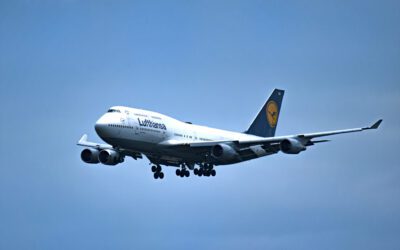The FAA Reauthorization Act of 2024 has two major problems. It doesn’t require the FAA to implement all emergency evacuations test recommendations and doesn’t require re-testing of existing aircraft with its updated test requirements, once promulgated.
 Last week, at San Francisco International Airport (SFO), the crew of American Airlines flight AA2045 was set to leave the terminal gate when the crew started to see smoke in the cabin. Soon after boarding was complete aboard the Airbus A321–200 a passenger’s laptop’s lithium-ion battery had caught fire and was reportedly in a carry-on bag billowing smoke. The smoke was filling the back of the cabin. Lithium-ion battery fires are beyond hard to extinguish.
Last week, at San Francisco International Airport (SFO), the crew of American Airlines flight AA2045 was set to leave the terminal gate when the crew started to see smoke in the cabin. Soon after boarding was complete aboard the Airbus A321–200 a passenger’s laptop’s lithium-ion battery had caught fire and was reportedly in a carry-on bag billowing smoke. The smoke was filling the back of the cabin. Lithium-ion battery fires are beyond hard to extinguish.
The crew called for the plane to be evacuated. The passengers cleared out of the cabin both via the jet bridge still positioned at the jet from the gate as well as from multiple emergency slides deployed by the crew.
The American Airlines plane evacuation was chaotic, with many passengers ignoring flight crew instructions while they took far too long exiting the aircraft.
Various reports from the plane, as well as seen in videos, show a plane in chaos with many passengers not listening to the flight crew. More than 2.5 minutes after the order to evacuate, some passengers are still not moving toward the jet bridge or the emergency chutes and more than a few are seen grabbing their carry-ons and personal items before exiting the plane, contrary to flight crew instructions. A few passengers suffered minor injuries exiting the plane.
As many who have been reading my columns know, a number of years ago, I was on a flight in Pittsburgh that had to be evacuated. After the emergency abort of our takeoff, the plane finally stopped just past the end of the runway. There was considerable smoke coming from the landing gear, but no fire anywhere, as we exited down the emergency chutes at night, in bitter cold, snowy weather.
During the airplane emergency evacuation I was in, there was panic, fear, hysteria, screaming and crying and was extremely chaotic.

While some passengers followed crew instructions and immediately headed for the exits, many scrounged for their bags from the floor where they had flown out of the overhead bins or grabbed for the few still in the bins. The aisle was quickly blocked with panicked passengers. Some passengers aggressively pushed others to get by, knocking some to the floor, slowing the evacuation interminably. The passengers who grabbed their bags at least doubled our exit time. I’d estimate it took almost ten minutes before the plane was empty.
Several passengers were injured during the emergency evacuation I was in, primarily because they failed to follow the crew’s instructions in the chaos that occurred.
Several passengers were injured during the evacuation. A woman who went down the emergency chute in front of me broke her leg. She was clutching her carry-on and purse to her body as she slid down the chute. The carry-on’s weight turned her around, out of control. She was lucky to only break her leg.
I’ve carefully reviewed actual Federal Aviation Administration (FAA) videos of aircraft evacuation tests, needed before an aircraft can be certified. One particular evacuation test that stood out to me was that of the Airbus A-380 in 2007. FAA regulations require aircraft to be able to evacuate everyone within 90 seconds or fail the test. The jetliner completed the evacuation test in 78 seconds, just 13 seconds from failure.
Unfortunately, that evacuation test, like every other evacuation test I’ve reviewed, was a “flight of fancy!” It was nothing like a real world evacuation, nothing like what I had in Pittsburgh nor what happened last week in San Francisco.
The Airbus A-380 evacuation test was totally unrealistic, with test passengers not remotely acting like real passengers in an emergency, making it possible for the plane to pass the test.
In the A-380 test evacuation, you can readily see that there was no panic. Everyone followed the crew’s instructions. No one misbehaved, pushed or grabbed luggage. Not a single test passenger hesitated going down the emergency chute. The test passengers looked like well-oiled automatons.
- The FAA has important requirements for their emergency evacuation test, unchanged to date, since 1987.
- Planes must be at full seating capacity, including crew members, and be fully evacuated in 90 seconds or less.
- The test participants must include specific percentages of adults, seniors (men and women) and children, but children aren’t actually required, nor are any disabled test passengers.
- Aircraft company and airline employees may be test passengers, but may not be seated next to an
- No practice evacuation is permitted.
- No more than half the exits may be opened and used for the test.
- The test must be run in darkness or simulated darkness.
Let’s look at the FAA’s evacuation test requirements with a critical eye.
When examining the FAA evacuation test requirements it’s clear to see that the requirements are highly deficient.
When you look more deeply at the specific requirements for the test, the FAA requires just five percent of the passengers be over 60 years of age. Based on statistical data, that percentage is no more than half the number needed for the test, as seniors will likely be the slowest physically during an evacuation. The test requires no disabled passengers, who would be even slower than seniors in the test. As mentioned, the FAA doesn’t require children participate in the test, not even teens. In my evacuation experience, children were extremely frightened and uncooperative. They can’t be left out of the tests.
To me, it’s patently absurd to have aircraft, airline or contractor employees participating in the tests. They have a vested interest in having the aircraft pass the test.
If you look at the video of the A-380 evacuation test for yourself, you’ll see the test passengers act like well-drilled soldiers following orders. Real world passengers in a real accident/crash/emergency are nothing like that. Real world evacuations are made by panicking passengers, not cool and collected aircraft and airline employees who know it’s only a test.
And 90 seconds to evacuate? In the AA2045 evacuation last week, the smoke was minimal, there was no fire or damage to the aircraft and the flight crew were clearly doing their job, yet 2.5 minutes after the evacuation began, a full minute past the 90 second test deadline, there were still passengers on the aircraft.
Real world airplane emergency evacuations are all-out chaos.
Real world evacuations aren’t like a well-oiled drill; they’re all-out chaos.
Congress must correct the evacuation test problems in the FAA Reauthorization Act of 2024.
This past May, President Biden signed H.R. 3935, the FAA Reauthorization Act of 2024, into law. The law includes the requirement that the FAA must study their evacuation test procedures in light of the problems I’ve described above and numerous other important issues, specifically to determine recommendations to improve the evacuation test.
While that’s great, there are two serious problems in the new law. The law doesn’t require that the FAA actually implement all the recommendations to improve the evacuation test. Moreover, the law is missing the critical requirement for re-testing existing aircraft with the hopefully superior and more realistic evacuation test in order to maintain their certification.

When the new Congress convenes in 2025, they must correct those defects in the FAA Reauthorization Act of 2024.
(Image: American Airlines A319 landing at Philadelphia International Airport. Copyright © 2018 NSL Photography. All Rights Reserved.)
READ ASLO:
10 tips for traveling with kids
15 tips to help you interpret hotel reviews to choose the best hotel for you
After many years working in corporate America as a chemical engineer, executive and eventually CFO of a multinational manufacturer, Ned founded a tech consulting company and later restarted NSL Photography, his photography business. Before entering the corporate world, Ned worked as a Public Health Engineer for the Philadelphia Department of Public Health. As a well known corporate, travel and wildlife photographer, Ned travels the world writing about travel and photography, as well as running photography workshops, seminars and photowalks. Visit Ned’s Photography Blog and Galleries.



